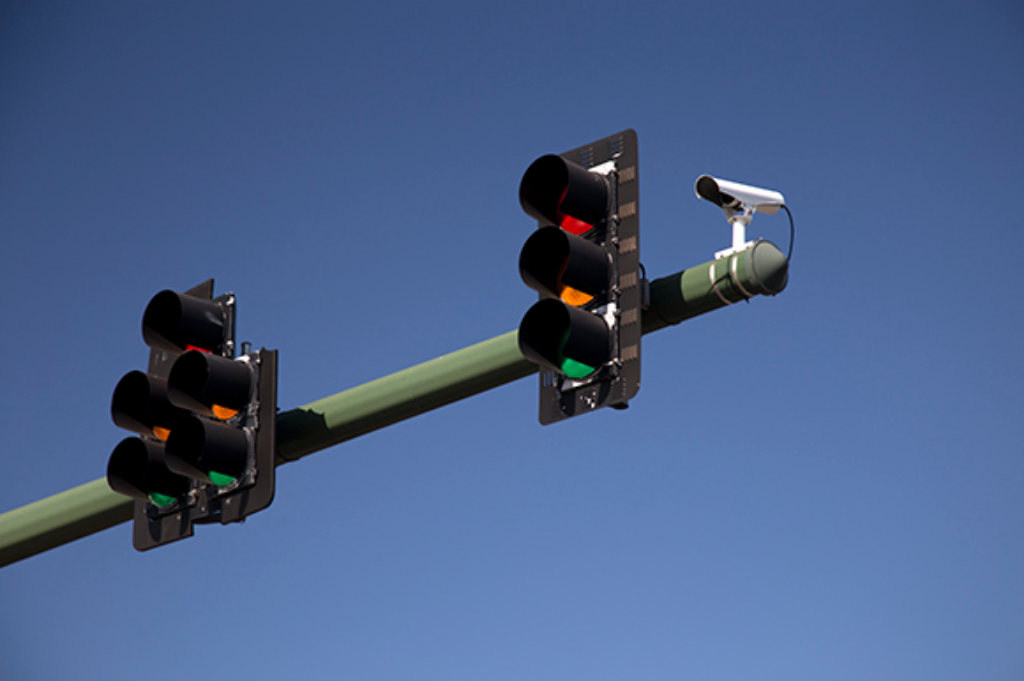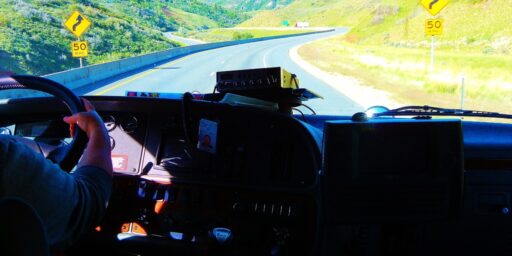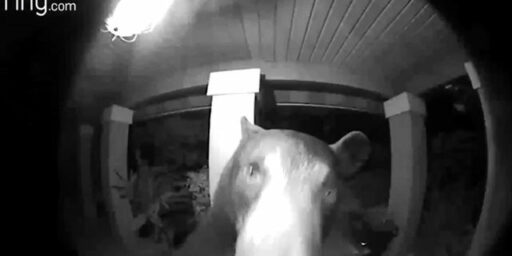Texas Bans Red-Light Cameras
Texas has become the latest state to eliminate red-light cameras amid increasing evidence that they are largely counterproductive.

Texas has become the latest state to outlaw red-light cameras after numerous complaints about the extent to which they had become little more than an easy method of generating revenue for localities:
On a recent morning in May, Carlos Barrientos drove up to a Belt Line Road intersection on his way to work in Grand Prairie, Tex. His breakfast sandwich, sports drink, backpack and papers were arranged around him and on the seats, so Mr. Barrientos, 23, tried to avoid making sudden moves.
Suddenly a yellow traffic light flickered overhead, followed seconds later, he said, by a red light. A camera flashed, catching his license plate when the vehicle edged close to the crossing or continued through it, he said. Days later, he received what will soon be a thing of the past for thousands of drivers in Texas: a $75 ticket for going through a red light based on the automated camera snapshot.
“It does not give you any warning,” Mr. Barrientos, who works in real estate investing and marketing, said in an interview. “All of a sudden, two seconds to brake in a whole intersection. Go over the white line, you will still get that ticket.”
With the signing of a bill last weekend, Gov. Greg Abbott made Texas the latest state to ban red-light traffic cameras.
It joins at least seven other states — Maine, Mississippi, Montana, New Hampshire, South Carolina, South Dakota and West Virginia — that already have statutes prohibiting the cameras, the National Conference of State Legislatures said. Around 20 more do not haveautomated traffic enforcement systems on public roads.
“Each state is responsible for prioritizing what devices go on their roadways,” the Federal Highway Administration said in an emailed statement.
The Texas ban takes effect on Sept. 1, but it allows communities more time, if needed, to complete their contracts with the private companies that operate the cameras — and get a flat fee or share revenue from the tickets.
The changes mean an end to the bane of cameras that drivers say pop into action too quickly, capturing an image of a license plate on a vehicle that has edged into a crossing while waiting to turn, only to be stuck at the moment the light changes to red. Others say the cameras are set off even if a car strays inches over a line marking the intersection, but then stops at the very last moment.
These and other frustrations were shared on social media as police departments across Texas announced this week that they were starting to deactivate their red-light cameras to comply with the new law. The Frisco Police Department said on Twitter on Monday that it would stop processing violations that it had been working on. The Haltom City Police Department said it had terminated its contract with Redflex Traffic Systems, the company that provided the cameras.
Mr. Barrientos, the driver who was given a ticket in Grand Prairie, was among the nearly 200 people who wrote to the Grand Prairie Police Department when it announced this week that it was ending enforcement action. Some said the cameras could be put to better use, or wondered whether to pay current tickets and if they would be reimbursed for tickets they already paid.
“Donate the cameras to Keep Grand Prairie Beautiful to catch those litter bugs !!!!!” one person wrote on the department’s Facebook page. Another resident suggested the cameras be repurposed in places “where our neighborhoods continue to get robbed.”
In Plano, a city of about 300,000 in North Texas, there was an average of about 17 traffic crashes a day before the red-light camera program was started in 2006. Chief Gregory W. Rushin of the Plano Police Department said in an interview on Friday that accidents decreased by about a third since cameras, under a $2 million contract with Redflex, were placed at intersections with the highest number of red-light runners and accidents.
Drivers or vehicle owners can contest the video and snapshot evidence sent to them with the citation, he said. Revenue from the tickets goes to trauma centers and to future traffic safety programs. “It’s not a money grab,” he said. “We are trying to save lives.”
Prior to the development and use of red-light cameras, of course, the odds of someone being caught running a red light were essentially limited to situations where a police officer happened to be in the area and see the infraction or where an accident took place and there was eyewitness testimony that one of the parties had run through the light. By all accounts, the installation of the systems has reduced the number of accidents in jurisdictions that have used them, largely due to the fact that drivers are aware of the camera’s existence and unwilling to risk a fine that, with court costs, could run as high as $100 for even a first offense. Those numbers notwithstanding, though, the systems have been universally controversial.
Critics of the cameras, though, have lodged a number of arguments against them, including the fact that they have also been shown to increase the number of accidents due to the fact that they cameras cause drivers to make sudden stops at intersections at times when the driver behind them might have assumed that they would continue through the light:
A 2016 report from the Florida Department of Highway Safety and Motor Vehicles found that intersections with red-light cameras saw increases in nearly every type of accident in the years since the cameras were installed. Rear-end crashes went up 11.41 percent, angle crashes went up 6.42 percent, and crashes involving injuries went up 9.34 percent. Fatalities from accidents doubled.
Similar trends can be seen across the nation. Cities including Los Angeles, Chicago, Philadelphia, and Washington, D.C., have all seen increases in crashes at intersections where red-light cameras have been installed. In Los Angeles, the number of accidents increased at 20 of the 32 camera-equipped intersections. Three other intersections saw accident numbers remain the same, and only nine saw a decrease.
Sometimes the cameras help reduce one type of accident but increase another. In Chicago, the city with the most red-light cameras, the cameras may have lowered the number of T-bone (broadside) collisions by 15 percent, but the number of injury-causing rear-end accidents went up by 22 percent. One could argue that T-bone collisions are often more dangerous than rear-end crashes, but the most recent data from Illinois’s Department of Transportation show an increase in traffic fatalities in Cook County, which contains Chicago, despite the ubiquity of these cameras.
Having driven in two states that have allowed communities to deploy red-light cameras in the past only to rescind that authority after it became apparent that the program wasn’t working out as planned, I can attest that the perceived safety impact is not as apparent as proponents claim. In both cases, motorists quickly became aware of which intersections had cameras and which didn’t. The result was that, while one might see a change in behavior at the intersections with cameras, there was no noticeable impact at the intersections where they weren’t in place. Since the systems are not easy to move, localities where essentially unable to do anything about this and driver behavior changed accordingly. Additionally, there is no equivalent to red-light cameras at intersections governed by “Stop” signs, so the cameras had no impact whatsoever.
Leaving aside the alleged safety argument, another argument made in favor of these systems is the argument that other localities have made, specifically the fact that the systems can be a revenue generator. Even assuming that revenue generation is a legitimate excuse for installing the systems, which is questionable to say the least, this is far from the truth as well and also creates some questionable motives for local officials:
In Miami, officials expected to collect $10.5 million during the current fiscal year on citations from the cameras. Of that, $4.4 million would go to American Traffic Solutions and the rest to the city coffers. That money will vanish when the city and American Traffic Solutions end their contract. But, as Suarez put it on Twitter, “It is necessary to defend #Miami‘s most vulnerable residents from continuing to be overburdened by these excessive fines.”
(…)
Some cities have gotten especially carried away with their revenue-raising ambitions. In Chicago, officials were caught speeding up yellow lights so they would turn red quicker than the city’s minimum of three seconds. That led to 77,000 additional tickets’ being written in 2014, creating $8 million in new revenue for the city. If it weren’t for inquiries from the Chicago Tribune and Inspector General Joseph Ferguson, citizens in the Windy City would have had no idea that this abuse was taking place.
The sketchy dealings of red-light-camera companies are not unique to Chicago. In Columbus, Ohio, the CEO of RedFlex, the city’s red-light-camera vendor, was charged with bribing city officials in exchange for a contract. Similar actions have reportedly taken place in 13 states throughout the U.S.
Given all of this, the arguments in favor of red-light cameras fail to withstand both logical examination and the available facts. Getting rid of them and returning to more traditional policing of dangerous intersections would both do more to making driving safer and prevent towns and cities from gouging drivers to cover the gaps in their budgets.






The traditional policing of dangerous intersections is to do nothing. I seem to be alone in supporting red light cameras. I’m just tired of seeing my light go green and having to sit while two or three vehicles cross in front of me, especially if I have a short left arrow and they use it up. A few years ago I was second in line. I saw somebody going fast out of the corner of my eye and didn’t go. Watched the guy in front of me get spun 180 in the intersection. Perhaps Mr. Barrientos should have been more aware of the dangers of driving and stowed his stuff better.
Yes, it’s corrupt, it’s done for the revenue. Which is also true of parking and speeding violations. The cops are lazy. They enforce speeding because they have an electric box that says, “He’s guilty.” If they had an electric box that said, “He made an unsafe lane change and didn’t signal” or “He made an illegal right on red” they’d enforce that. That’s the way of the world. Get over it.
I wonder how much the effectiveness of red light cameras depends on the driving habits, or style, prevalent in a given area.
A more effective way to enforce red lights, if one cares about fairness, would be to take video 24/7, having an algorithm signal violations, and then having actual human officers review each one and exercise judgment on each. But then that would defeat the revenue aspect, right?
As to style or habit, in Mexico City red lights are seen three ways, depending on the type of intersection they are in: 1) ignore it, 2) “you may want to consider stopping here if it’s not too much trouble,” and 3) STOP YOU MANIAC!! DO YOU WANT TO GET KILLED!
This can vary with time of day, traffic conditions, and urgency to reach one’s destination.
@Kathy: My minimal experience as a passenger in Mexico City (our distributor would not allow Gringoes to drive) was not such that I’d like to repeat it at home. Nor Boston, where I have driven.
I only can claim to know California traffic law, but I know that pretty well. And in CA traffic law, if you are already in the intersection when the light turns red, you have not violated the traffic signal law. The first story seems to suggest that this works differently in Texas? Maybe Mr. Barrientos could successfully argue his case in traffic court?
There is also a “don’t block the box” law, I think. But just a creeped presence isn’t really enough to trigger a ticket for that.
The gouging is, I think, easy enough to remedy: all fines should go to the state, which then disburses the money as it sees fit. Should safety dictate installing one of these cameras, please go ahead. But let’s help cities stay on the straight and narrow by removing any conflicts of interest.
@Jay L Gischer: Unfortunately the problem for the driver is that the photographic evidence doesn’t establish that you were already in the intersection when the light turned red, only that you hadn’t cleared the intersection before the light turned red, which is the basis of the infraction–at least where I live.
Speed bumps would work…
I wouldn’t want them on every stop sign intersection, but if there are particularly dangerous ones, sure.
Alternately, a video camera and a bit of software could check that cars are stopping.
Research does not show that red light cameras are ineffective, it shows that if allow people to tailgate then red light cameras can increase accidents. Punish people that tailgate, force people to decrease speed when reaching to the red light and then you’ll have far less accidents.
Red Light Cameras are not the issue, aggressive and bad driving are.
@Jay L Gischer: In Texas if you legally entered the intersection prior to the light changing red you are allowed to complete you turn or whatever. The cameras didn’t care and would snap pictures that could be tossed out after wasting your time. Also they would decrease the yellow time a little when they installed the cameras…
@Gustopher:
Speed bumps should be used as little as possible(To me, they should be only used in the entrance of cities, when speed should be lower). They destroy the car and are not that effective for people that drive SUVs. Just use speed cameras to enforce speed limits, that should be lower in urban areas.
Let me get this straight: I’m supposed to feel sympathy for someone who is both eating and drinking while driving, with the food and drink (and other impedimenta) loose in the cabin instead of secured, and who is unaware that red lights always follow yellow lights “seconds later”?
Throw the book at him.
Similarly for people who rear-end those who stop for red lights.
I do understand your complaint about inconsistent deployment. The solution is for these cameras to be everywhere. I’m sick and tired of the “right to drive dangerously” crowd, and I join @gVOR08 in supporting camera enforcement. There may be a learning period (that will generate a lot of needed revenue for police departments), but in the long run we will all be safer.
@Gustopher:
Speed bumps are a disaster. They turn steady traffic at a mostly constant speed into stop-and-start as people brake for the bump, then accelerate and decelerate sharply between bumps.
The two traffic-calming techniques I’ve seen that actually work are (1) pavement grooves that cause an annoying noise at speeds over 25 mph, and (2) narrowing the lane (e.g. by carving out a bunch of pavement for parking and/or bicycle lanes), so that the visual enticement to speed is not as great.
@DrDaveT:
Brazil might have horrible traffic, but at least this is a traffic violation.
SEE the 1939 documentary-“the City”-for suggestion of an “AI condition in the system”–and one scene depicting an “automated traffic policeman’—When the ‘internet was still ‘invisible’—but working silently-“SKYTRAINZASTRON”–UFO Research–of time-space–and unseen visitor’s–from long ago–Colony Of Rusty Iron–
Back in 1969 or so I had a job as an overdimension load pilot car driver-One day I witnessed a Chicago Yellow Cab broadside another automobile at a stop light.After 140,000 miles of escorting I decided to quit the job–I actually felt I had been “lucky” up to that point having had an occasional “near miss”.–On the west side of Chicago–at that time there was at least one street with “synchronized” traffic light’s –if you maintained 25 0r 30 mph–as posted–you could could travel several block’s without encountering a red light–interesting application of automation for convenience at an earlier time.Those did work out fairly well— but keeping your” eyes open”—so to speak– is still is a good idea–alway’s expectect the unexpected-